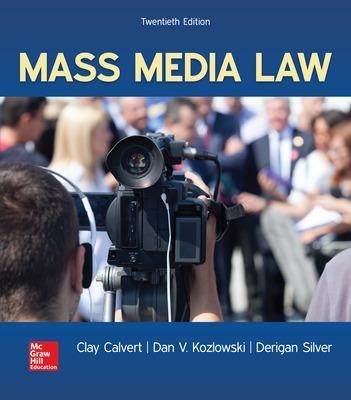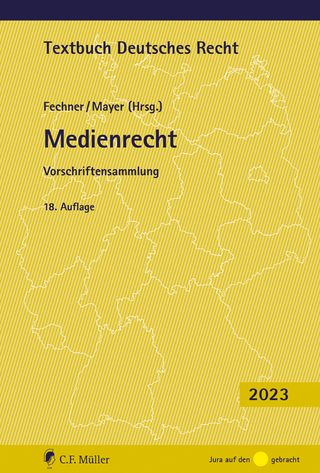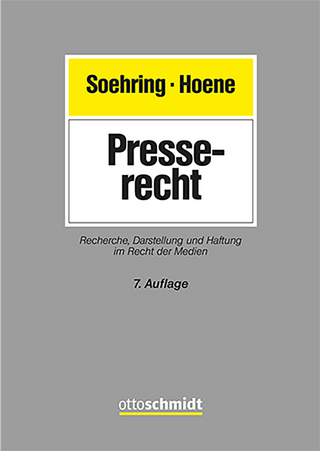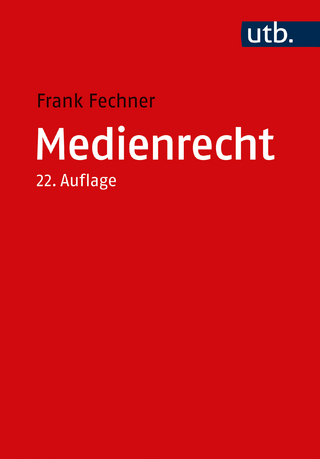
Mass Media Law
McGraw-Hill Education (Verlag)
978-1-259-91390-7 (ISBN)
- Titel ist leider vergriffen;
keine Neuauflage - Artikel merken
Instructors and students can now access their course content through the Connect digital learning platform by purchasing either standalone Connect access or a bundle of print and Connect access. McGraw-Hill Connect® is a subscription-based learning service accessible online through your personal computer or tablet. Choose this option if your instructor will require Connect to be used in the course. Your subscription to Connect includes the following:
SmartBook® - an adaptive digital version of the course textbook that personalizes your reading experience based on how well you are learning the content.
Access to your instructor’s homework assignments, quizzes, syllabus, notes, reminders, and other important files for the course.
Progress dashboards that quickly show how you are performing on your assignments and tips for improvement.
The option to purchase (for a small fee) a print version of the book. This binder-ready, loose-leaf version includes free shipping.
Complete system requirements to use Connect can be found here: http://www.mheducation.com/highered/platforms/connect/training-support-students.html
Clay Calvert is Professor and Brechner Eminent Scholar in Mass Communication in the College of Journalism and Communications at the University of Florida in Gainesville, where he also directs the Marion B. Brechner First Amendment Project. He has taught undergraduate media law classes for more than twenty years.
Chapter 1 The American Legal System
Sources of the Law
Common Law
The Role of Precedent
Finding Common-Law Cases
Equity Law
Statutory Law
Constitutional Law
Executive Orders and Administrative Rules
SUMMARY
The Judicial System
Facts versus the Law
The Federal Court System
The Supreme Court
Other Federal Courts
Federal Judges
The State Court System
Judicial Review
SUMMARY
Lawsuits
SUMMARY
Bibliography
Chapter 2 The First Amendment: The Meaning of Freedom
Historical Development
Freedom of the Press in England
Freedom of the Press in Colonial America
Community Censorship, Then and Now
SUMMARY
The First Amendment
The New Constitution
Freedom of Expression in the 18th Century
Freedom of Expression Today
SUMMARY
The Meaning of Freedom
Seditious Libel and the Right to Criticize the Government
Alien and Sedition Acts
Sedition in World War I
The Smith Act
Defining the Limits of Freedom of Expression
Real-Life Violence: Blaming Movies, Video Games and Books
The Gitlow Ruling and the Incorporation Doctrine
SUMMARY
Prior Restraint
Near v. Minnesota
Pentagon Papers Case
Progressive Magazine Case
United States v. Bell
SUMMARY
Bibliography
Chapter 3 The First Amendment: Contemporary Problems
The First Amendment in Schools
Censorship of Expression in Public High Schools
The Hazelwood Case
The Bethel Case
The Morse Case
Censorship of College
Newspapers
Problems for College Journalists
Alcohol Advertisements and the College Press
Book Banning
SUMMARY
Time, Place and Manner Restrictions
Forum Analysis
SUMMARY
Other Prior Restraints
Son of Sam Laws
Prior Restraint and Protests
SUMMARY
Hate Speech/Fighting Words
SUMMARY
The First Amendment and Election Campaigns
SUMMARY
The First Amendment and the Information Superhighway
Net Neutrality
Bibliography
Chapter 4 Libel: Establishing a Case
The Libel Landscape
Damage Claims
Time and Money
Time and the Law
The Lawsuit as a Weapon
Resolving the Problem
SUMMARY
Law of Defamation
Elements of Libel
Publication
Publishers and Vendors
Libel on the Internet
Identification
Group Identification
Defamation
Crime
Sexual References
Personal Habits
Ridicule
Business Reputation
Criticism of a Product
Falsity
SUMMARY
Bibliography
Chapter 5 Libel: Proof of Fault
New York Times v. Sullivan
The Rationale for the Ruling
Public Persons versus Private Persons
Who Is a Public Official?
Job Description
The Nature of the Story
All-Purpose Public Figures
Limited-Purpose Public Figures
Lower-Court Rulings
The Nature of the Controversy
The Plaintiff ’s Role
Businesses as Public Figures
Public Persons Over Time
Involuntary Public Figures
SUMMARY
The Meaning of Fault
Negligence
Actual Malice
Knowledge of Falsity
Reckless Disregard for the Truth
Applying the Actual Malice Standard
SUMMARY
Intentional Infliction of Emotional Distress
SUMMARY
Bibliography
Chapter 6 Libel: Defenses and Damages
Summary Judgment/Statute of Limitations
Statute of Limitations
Jurisdiction
Jurisdiction and the Internet
SUMMARY
Truth
Privileged Communications
Absolute Privilege
Qualified Privilege
Neutral Reportage
Abuse of Privilege
SUMMARY
Protection of Opinion
Rhetorical Hyperbole
The First Amendment
The Ollman Test
Fair Comment and Criticism
SUMMARY
Defenses and Damages
Consent
Right of Reply /Self-Defense
Damages
Compensatory Damages
General or Actual Damages
www.mhhe.com
Special Damages
Presumed Damages
Punitive Damages
Retraction Statutes
SUMMARY
Criminal Libel
Bibliography
Chapter 7 Invasion of Privacy: Appropriation and Intrusion
Conceptions and Sources of Privacy in the United States
Invasion of Privacy
The Growth of Privacy Laws
Appropriation
Right of Publicity
Use of Name or Likeness
Advertising and Trade Purposes
News and Public Interest Exception
Other Exceptions
Booth Rule
Consent as a Defense
When Consent Might Not Work
Life After Death: Post-Mortem Publicity Rights
SUMMARY
Intrusion
Intrusion and the Press
No Privacy in Public
The Use of Hidden Recording Devices
Intrusion by Drones
Intrusion and the Publication of Information Obtained Illegally
SUMMARY
Bibliography
Chapter 8 Invasion of Privacy: Publication of Private Information and False Light
Public Disclosure of Private Facts
Publicity
Private Facts
Naming Rape Victims
Highly Offensive Publicity
Legitimate Public Concern and Newsworthiness
Ethics and Privacy
Recounting the Past
Private Facts on the Internet
SUMMARY
False-Light Invasion of Privacy
Fictionalization
Other Falsehoods
Highly Offensive Material
The Fault Requirement
SUMMARY
Bibliography
Chapter 9 Gathering Information: Records and Meetings
News Gathering and the Law
The Constitution and News Gathering
Access to Government Officials: A Right to Interview?
The First Amendment Protection of News Gathering
SUMMARY
The Freedom of Information Act
Recent FOIA Reforms
Agency Records
What Is an Agency?
What Is a Record?
What Is an Agency Record?
FOIA Exemptions
National Security
Housekeeping Practices
Statutory Exemption
Trade Secrets
Working Papers/Discovery
Personal Privacy
Law Enforcement
Financial Records
Geological Data
Handling FOIA Requests
Federal Open-Meetings Law
SUMMARY
State Laws on Meetings and Records
State Open-Meetings Laws
State Open-Records Laws
The Privatization of Public Government
SUMMARY
Laws That Restrict Access to Information
School Records
Health and Medical Records
The Federal Privacy Law
Criminal History Privacy Laws
State Statutes That Limit Access to Information
SUMMARY
Bibliography
Chapter 10 Protection of News Sources/Contempt Power
Journalists, Jail and Confidential Sources
News and News Sources
The Failure to Keep a Promise
Constitutional Protection of News Sources
Lower-Court Rulings
Civil Cases
Criminal Cases
Grand Jury Proceedings
Nonconfidential Information and Waiver of the Privilege
Who Is a Journalist?
Telephone Records
SUMMARY
Legislative and Executive Protection of News Sources
Shield Laws
Federal Guidelines
Newsroom Searches
How to Respond to a Subpoena
SUMMARY
The Contempt Power
Kinds of Contempt
Contempt and the Press
Collateral Bar Rule
SUMMARY
Bibliography
Chapter 11 Free Press–Fair Trial: Trial-Level Remedies and Restrictive Orders
Prejudicial Crime Reporting
Impact on Jurors
The Law and Prejudicial News
SUMMARY
Traditional Judicial Remedies
Voir Dire
Change of Venue
Continuance
Admonition to the Jury
Sequestration of the Jury
SUMMARY
Restrictive Orders to Control Publicity
Restrictive Orders Aimed at the Press
Restrictive Orders Aimed at Trial Participants
Contact with Jurors
SUMMARY
Bibliography
Chapter 12 Free Press–Fair Trial: Closed Judicial Proceedings
Closed Proceedings and Sealed Documents
Open Courts and the Constitution
Open and Closed Trials
Suspected Terrorists, Enemy Combatants, Et Al.
SUMMARY
Closure of Other Hearings
Accessible and Inaccessible Documents
Access and the Broadcast Journalist
Access to Evidence
Recording and Televising Judicial Proceedings
SUMMARY
Bench-Bar-Press Guidelines
SUMMARY
Bibliography
Chapter 13 Regulation of Obscene and Other Erotic Material
The Law of Obscenity
Early Obscenity Law
Defining Obscenity
SUMMARY
Contemporary Obscenity Law
The Miller Test
An Average Person
Community Standards
Patent Offensiveness
Serious Value
Other Standards
Variable Obscenity
Child Pornography
Children as Child Pornographers and Sexting
Obscenity and Women
SUMMARY
Regulation of Nonobscene Erotic Material
Sexually Oriented Businesses
Attacks on the Arts and Popular Culture
Erotic Materials in Cyberspace
The Communications Decency Act
The Child Online Protection Act
The Children’s Internet Protection Act
Current Issues Online: The New “Dot XXX” Domain
SUMMARY
Bibliography
Chapter 14 Copyright and Trademark
Intellectual Property Law
Patents
Trademarks
Roots Copyright
What May Be Copyrighted
Copyright and Facts
Telephone Books and Databases
News Events
Research Findings and History
Misappropriation
Duration of Copyright Protection
SUMMARY
Fair Use
Purpose and Character of Use
Nature of the Copyrighted Work
The Portion or Percentage of a Work Used
Effect of Use on Market
Application of the Criteria
SUMMARY
Copyright Protection and Infringement
Copyright Notice
Registration
Infringement
Originality of the Plaintiff ’s Work
Access
Copying and Substantial Similarity
Copyright Infringement and the Internet
Digital Millennium Copyright Act
File Sharing
Film and Television
SUMMARY
Freelancing and Copyright
Damages
Bibliography
Chapter 15 15 Regulation of Advertising
Advertising and the First Amendment
Commercial Speech Doctrine
Compelled Advertising Subsidies and Government Speech
SUMMARY
The Regulation of Advertising
Self-Regulation
Lawsuits by Competitors and Consumers
State and Local Laws
Federal Regulation
Telemarketing
Regulating Junk E-Mail and Spam
SUMMARY
Federal Trade Commission
False Advertising Defined
Means to Police Deceptive Advertising
Guides and the Children’s Online Privacy Protection Act Voluntary Compliance
Consent Agreement
Litigated Order
Substantiation
Corrective Advertising
Injunctions
Trade Regulation Rules
SUMMARY
The Regulatory Process
Procedures
Special Cases of Deceptive Advertising
Testimonials
Bait-and-Switch Advertising
Defenses
Advertising Agency/Publisher Liability
SUMMARY
Bibliography
Chapter 16 Telecommunications Regulation
A Prologue to the Present
History of Regulation
The Changing Philosophy of Broadcast Regulation
The Prometheus Decision and Continuing Fallout
SUMMARY
Basic Broadcast Regulation
Federal Communications Commission
Powers
Censorship Powers
Licensing
Multiple Ownership Rules
License Renewal
The Public’s Role and Online Public Inspection Files
SUMMARY
Regulation of Program Content
Sanctions
Regulation of Children’s Programming
Obscene, Indecent and Profane Material
Violence on Television
SUMMARY
Regulation of Political Programming
Candidate Access Rule
Equal Opportunity/Equal Time Rule
Use of the Airwaves
Legally Qualifi ed Candidates
SUMMARY
News and Public Affairs
Video News Releases, Sponsorship Identification and the FCC
The First Amendment
SUMMARY
Regulation of New Technology
Satellite Radio
Internet and Broadband
Cable Television 679
Federal Legislation Regulating
Cable Television
Purpose of the Law
Jurisdiction and Franchises
Must-Carry Rules
Programming and Freedom of Expression
SUMMARY
Bibliography
| Erscheinungsdatum | 16.12.2017 |
|---|---|
| Verlagsort | OH |
| Sprache | englisch |
| Maße | 203 x 231 mm |
| Gewicht | 1100 g |
| Themenwelt | Recht / Steuern ► EU / Internationales Recht |
| Recht / Steuern ► Privatrecht / Bürgerliches Recht ► Medienrecht | |
| Sozialwissenschaften ► Kommunikation / Medien ► Medienwissenschaft | |
| ISBN-10 | 1-259-91390-2 / 1259913902 |
| ISBN-13 | 978-1-259-91390-7 / 9781259913907 |
| Zustand | Neuware |
| Haben Sie eine Frage zum Produkt? |
aus dem Bereich


